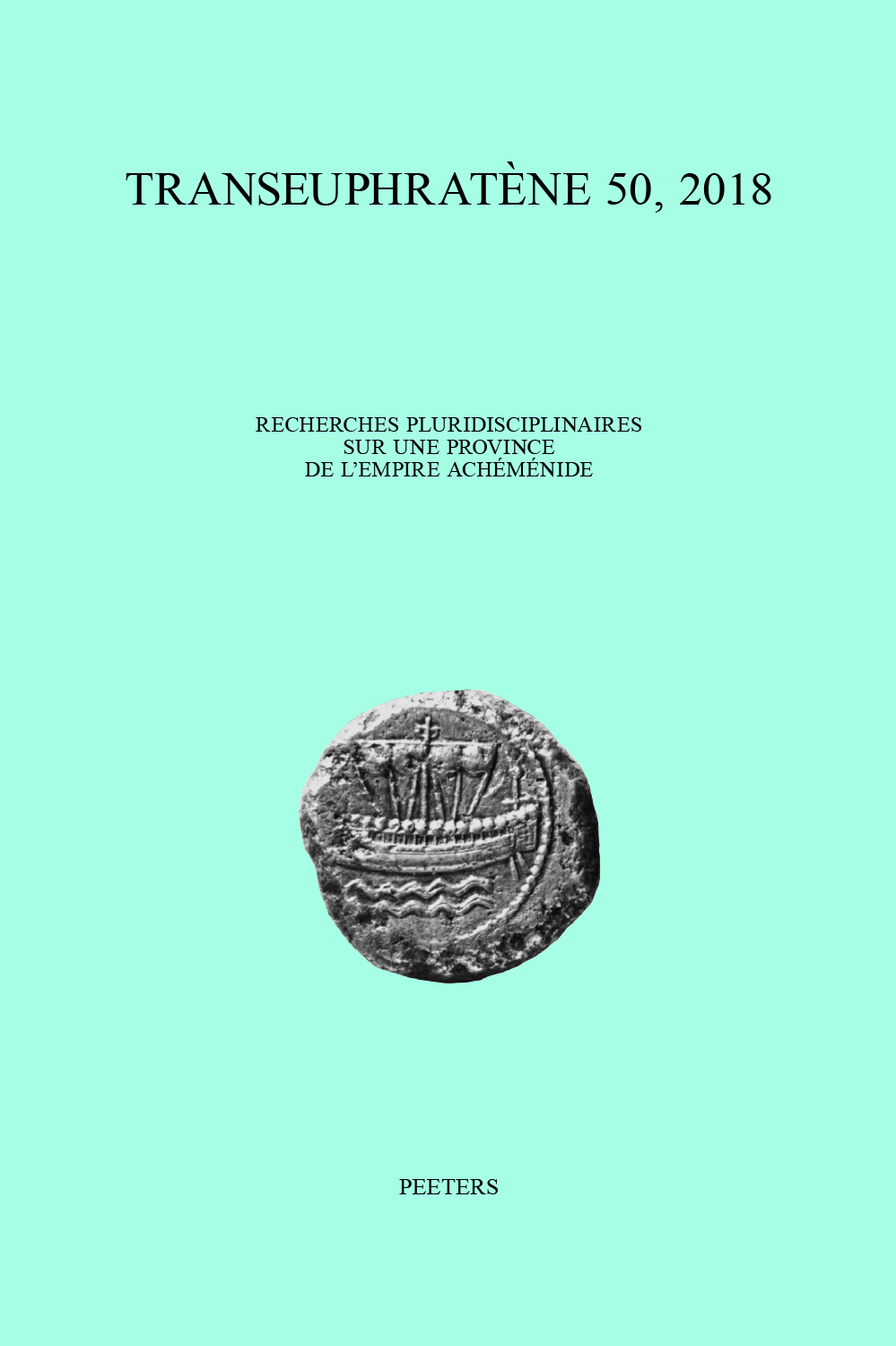 previous article in this issue previous article in this issue | next article in this issue  |

Preview first page |
Document Details : Title: Dry Climate during the Early Persian Period and its Impact on the Establishment of Idumea Author(s): LANGGUT, D. , LIPSCHITS, O. Journal: Transeuphratène Volume: 49 Date: 2017 Pages: 135-162 DOI: 10.2143/TE.49.0.3248524 Abstract : In the 8th-7th centuries BCE the southern border of Judah included the southern Lowland (Shephelah), the southern hill country and the Beer-sheba–Arad Valley. In this southern fringe of Judah, Judeans lived side by side with tribes that were of Edomite and Arab origin. In the 4th-3rd centuries BCE the Province of Idumea included all the areas of the Beer-sheba–Arad Valley, the southern Shephelah and the southern Judean Hills; the majority population in the region was Idumean and Arab. The borders of Yehud had shrunk to a line north of Beth-Zur in the hill country and Azekah and the Ellah Valley in the Shephelah, and most of the Judahite population was concentrated around Jerusalem. Explanations for these historical, geopolitical, cultural and demographic changes have been well-discussed by scholars; in this paper, we provide a set of paleo-environmental data that sheds new light on this process. Palynological and sedimentological information show that during the late 6th through the mid-5th centuries BCE (~ 520-450 BCE) dryer climate conditions were prevalent in the region. During the early Hellenistic period, wet climate conditions and intense olive horticulture characterized the region. Since in the steppe-marginal areas of the southern Levant, even minor climatic variation can result in major environmental change, the main argument of this paper is that the dry conditions in the early Persian period caused a process of abandonment of most of the villages in the southern parts of the former Kingdom of Judah, triggering nomadization of some elements of the local population and immigration to the core areas of the province of Yehud of others. After the destruction of the Kingdom of Judah and the collapse of the southern settlement and military system, this process provoked a demographic vacuum in the southern Lowland (Shephelah), the southern hill country and the Beer-sheba–Arad Valley that encouraged the immigration of nomadic elements into it. The gradual increase in moisture in the late 5th and 4th centuries BCE probably reinforced a cultural progressing, by stabilizing the settlements that were highly dependent on water resources and local agriculture. The semi-nomadic elements could have easily settled in the area and quickly created the settlement alignment of the province of Idumea. Au 8ème et 7ème s. av. n. è., la frontière sud du royaume de Juda incluait le sud de la plaine côtière (Shéphélah), le sud de la zone montagneuse ainsi que la vallée de Beer-sheba et Arad. La population judéenne vivait dans l’ensemble de cette région, aux côtés de tribus d’origines édomite et arabe qui vivaient à l’extrémité sud de Juda. Aux 4ème et 3ème s., la province d’Idumée comprenait toute la zone de la vallée de Beer-sheba et Arad, le sud de la Shéphélah ainsi que le sud des collines judéennes; la population édomite et arabe était majoritaire dans la région. Le territoire de Yehud s’arrêtait à une ligne au nord de Beth-Zur dans la zone montagneuse, et à Azékah et la vallée d’Elah dans la Shéphélah; la plupart de la population judéenne était concentrée autour de Jérusalem. Les explications pour ces changements historiques, géopolitiques, culturels et démographiques sont bien connues; nous présentons toutefois de nouvelles données paléo-environnementales qui apportent un nouvel éclairage. Les informations palynologiques et sédimentologiques montrent que vers la fin du 6ème et la première moitié du 5ème s. (environ 520-450) des conditions climatiques plus sèches étaient récurrentes dans la région. Le début de l’époque hellénistique, en revanche, est marqué par des conditions climatiques humides dans la région, permettant une intense oléiculture. Étant donné que dans les zones marginales des steppes du Levant sud, même des variations climatiques mineures peuvent provoquer des changements environnementaux importants, la thèse principale de cet article est que les conditions arides du début de l’époque perse ont causé l’abandon de la plupart des villages dans les zones sud de l’ancien royaume de Juda, ainsi que l’immigration de la plupart des habitants vers le cœur de la province de Yehud. Ce processus a provoqué un vide démographique qui a encouragé l’immigration de groupes nomades à la place, une immigration qui avait en tout cas déjà commencé suite à la destruction du royaume de Juda et l’effondrement de l’habitation dans le sud ainsi que du système militaire. La montée progressive de l’humidité vers la fin du 5ème et au 4ème s. a probablement renforcé le développement de la culture, en stabilisant les habitations qui étaient fortement dépendantes en eau et en agriculture locale. Les groupes semi-nomades ont pu s’installer facilement dans la région et atteindre en un rapide processus l’alignement de l’habitation dans la province d’Idumée. |
|


